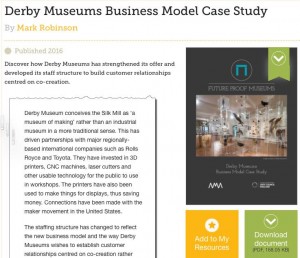Last year I was commissioned by the Arts Marketing Association to research and write a large set of case studies looking at arts organisation and museum business models, using the Business Model Canvas, devised by Osterwalder & Peignuer. This is a format that, with some additions I’ll come to, I’ve used regularly with many organisations of different types and scales over the last few years, so it was an interesting opportunity to dig a bit deeper into the format, as well as into some fascinating organisations.
The case studies were based on interviews and examination of several years of annual accounts and reports. This last led to my new top tip to organisations seeking funding or investment: take your annual report seriously as an opportunity to portray yourself to the world, not just as a statutory duty, they are your visible portraits. Remember: someone might look at them to try and understand you.
The 18 case studies were used as part of the AMA’s Future Proof Museums programme last year, inform the new online learning resource Building Resilience, and have now all been uploaded onto the CultureHive website, along with some introductions to the Business Model Canvas and a piece discussing some patterns and outliers. In that I pose six questions, which I think have relevance at both individual organisation or group level and at sectoral levels.
Those questions are:
Q1. Can you talk clearly, simply and powerfully about your business model and your value?
It is simplistic to suggest that all cultural organisations can achieve the often-cited ‘third/third/third’ financial mix of public, private and earned income. But how common do we hear a realistic and clear alternative set out? One use of the Canvas can be to help people talk more powerfully about how an arts business works and what value it makes with or for people.
Q.2 Does your adapted Value Proposition fit well with your mission, purpose and your customers?
One limitation of the Business Model Canvas as applied to arts and cultural organisations is that there is no specific way to accommodate purpose or mission, especially where this is charitable in nature rather than financial. When working with people I have added a ‘Mission’ section to the Canvas to make sure this aspect is not lost. A number of the case studies talked powerfully about how re-emphasising the charitable purpose of their organisation had been important in reviewing and renewing their business models and work. (This made me think, again, how many arts ‘charities’ pay too little attention to the responsibilities of that legal structure.)
Q.3 Does your business model reflect your values?
The Business Model Canvas doesn’t explicitly reference Values. These are often reflected in the Customer Relationships where we articulate what kind of relationship the model needs to establish with customers. It is crucial, however, that the model, whatever, it is, is in keeping with your values: it’s a fool’s game to set up a model reliant on income from sponsors whose interests don't sit with those of the communities or audience groups you want o work with, for instance.
Q.4 Are you making the best use of your particular crisis?
There is a cliche that every crisis is actually an opportunity. A surprising number of people interviewed for these case studies related stories of how crisis had been useful to them, although the nature of the crisis varied widely. Some talked about crises of finance, where income had fallen and left a hole in the budgets. Others talked about facing a crisis of relevance that had gradually emerged as their business lost its community or audience backing. One small organisation talked of a crisis of short-termism - a common syndrome as organisations grow. For others the crisis was one of performance dropping or of stakeholders changing priorities.
Q.5 What role do your Key Partners play in your business model and in the model for the sector as a whole?
It is a truth universally acknowledged that a cultural organisation in possession of a mission and a Value Proposition must be in need of a partner. The range of ways in which people had opened up their businesses to partners – including audiences in some cases – was striking. Although the Canvas is useful as a design tool, don't forget that many models end up being co-designed, one way or another.
Q.6 Are you adapting your business model as a whole or just one element?
Although it was most common to see innovation driven by changes to the offer and the overall Value Proposition, Key Partners and Customer Segments also played a big part. Understanding of customers, increasingly informed by data that allows mining for behaviours as well as demographics, can be seen to shape offer and resources - as in Beamish’s development of a new 1950s town. What was common with those I spoke to was a desire to see the business model as a whole. Leaders recognised a need to avoid continually adding on ‘sub-business models’ designed simply to increase Revenue Streams, without considering the whole business. This means that staffing, partnerships and crucially the Value Proposition to customers can be aligned as the model adapts.
I'll be leading sessions on using the Business Model Canvas (with my humble additions) at the AMA Conference in Edinburgh 12-14 July. The theme is 'on a mission to matter', the importance of which comes through all the case studies.
The 18 case studies are of the organisations listed below, and I’d like to thank here people from each of the organisations for their time and help in developing the case studies.
Allenheads Contemporary Arts
a-n
Arts at the Old Fire Station, Oxford
Beamish Museum
Black Country Living Museum
Bloodaxe Books
Castlefield Gallery
Derby Museums
Hackney Empire
Ironbridge Gorge Museum
Live Theatre
MAC Birmingham
Ministry of Stories
Red Earth Theatre
Santa Cruz Museum of Art & History
South Bank Centre
Watershed
Western Australia Museum

Comments
Post a Comment